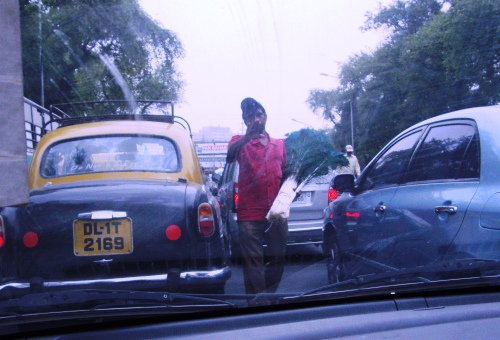Feathers Sold Openly Even as MoEF Proposes Ban on Trade of Peacock Feathers

In response to numerous requests from various stakeholders, the central Ministry of Environment & Forests (MoEF) is in the process of completely banning the trade of peacock feathers. Despite this, the selling of feathers of our National Bird is rampant across the Delhi NCR. Though the usual street shops are no longer selling these openly, the feathers can still be seen being sold on the streets around CP and ITO and even in markets like Kamla Nagar and Sarojini.
The demand for the feathers far outsrips the supply leading to rampant poaching and killing of the birds. Sections 43(3)(a) and 44 of the Wildlife Protection Act 1972 relates to the transfer and sale of the tail feathers of peacocks. Currently, the Act prohibits the killing of peacocks as well as export of tail feathers or articles made from them. But domestic trade in feathers or articles is allowed under the assumption that these are naturally shed. This is what is exploited by the domestic traders and is therefore being amended by the MoEF.

Delhi has a healthy peacock population thanks to the patches of green spaces in almost all districts of the NCT. In fact, we have received numerous emails especially from residents of Palam about the issue of too many peacocks and therefore the birds becoming easy target of children and even dogs. Even the Central Delhi area has a rich peacock population which is rivaled only by Delhi University even though rampant construction in the city and consequent habitat destruction is now threatening their safety.
While this ensures that at least some of the feathers being traded may well be fallen ones, that still does not help in any manner. The feathers, as do any other part of the bird or animals, belong to nature and need to be left at that. These enrich the soil with nutrients and inputs that were supposed to remain in the top soil, not in your living room. Just like a tiger skin is best on the tiger, peacock feathers are best on the bird, or in the soil. Taking them away is like burning the fallen leaves instead of letting them decompose, and should be banned likewise.
Top image by Impuri Shimray, bottom image courtesy AnitaWPANewDelhi




Dear Debangana,
Please do not collect feathers of any kind, and if you really must, please only collect fallen feathers of birds that you see around your house like pigeons and crows. Please also inform your school that fallen feathers and all animal/bird parts hold food and nutrients in them that must be left in the soil so it can be returned to Mother Nature.
Please DO NOT buy peacock feathers and inform your school that the Government is about to make the buying and selling of peacock feather as illegal and a crime. We are glad you shared your doubts with us and appreciate your time in thinking about Nature. Wish you all the best.
I am a student of class VI I have been told to collect types of feathers
I have been told that peacock is a must as it is sold here and there but I have not bought it yet as i am afraid that they are killed.
I have just collected 2 feathers fallen down of pigeons
I dont know if I should buy it or not
Dear Sir,
The decision of the government of India will save cruel activities are being done on peacocks , the pouchers do not kill peacocks only for feathers but for meat, bones and head too.India export peacock feathers to foreign countries which they purchase for their cocepts and medicinal purposes and dependency on natural fall may bind the business so they kill the bird due to gap in production and supply.
How ever their will be about three to four thosands Digamber monks who require pinchis after every six months and try to carry non requirabla weight while purpose can be solved by 1/10 th feather pinchi. in this way Jain monks require about 30000 thousand peacocks for their requirment and so poaching is possible. They must now come on synthetics of the same nature, performance and beauity.
Friends
Greetings
It is heartening to share that on way to Sariska, we stopped over at Tijara, a village known for Jain temples in Alwar district. There are a number of peacocks crossing the road, the lanes, places near the dharmashalas, the bazar everywhere. In the small rural town, we see peacocks from a close range. Even in the temple floor, the peacock would just walk into, not knowing it is a prayer place and cooly go over. This place is heaven for peacocks.
Alas, after leaving the town on way to Alwar, we watched some traders sitting. Initially we thought that they could be marketing the marble statutes or their animals. But to our dismay, these traders were infact selling openly the feathers of the peacocks, nobody could question them from where they collected. A young child of ten/eleven years confided to me that dadu kills the peacocks every morning and does the trade. Let somebody wake up the govt. Our requests to lodge a complaint near the Alwar Railway Station, the tourist office fell on deaf ears. Even at Sariska, we tried talking to Forest Department officials, he simply said, these people have to live and make their life by doing so.
Narendera K Gupta
Prof of HR Mgt
hrmnkg12@rediffmail.com
m 9810685704